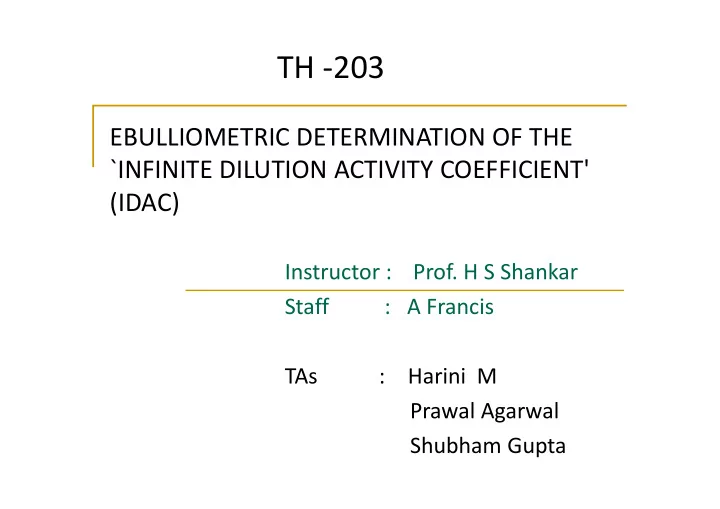

TH -203 EBULLIOMETRIC DETERMINATION OF THE `INFINITE DILUTION ACTIVITY COEFFICIENT' (IDAC) Instructor : Prof. H S Shankar Staff : A Francis TAs : Harini M Prawal Agarwal Shubham Gupta
AIM To determine "Infinite Dilution Activity Coefficient" (IDAC) of � a binary mixture at atmospheric pressure using differential ebulliometry and the limiting slope method. To estimate the parameters in the activity coefficients To estimate the parameters in the activity coefficients � � correlations such as Van Laar/Wilson.
Infinite Dilution Activity Coefficient (IDAC) � At infinite dilution the deviation from ideality occurs. � Phase equilibrium calculation can be performed using IDAC. using IDAC. � Parameters of activity coefficient model can be determined.
Theory of IDAC � Assuming Ideal Vapour Phase and Negligible Poynting correction 0 0 P = γ x p + γ x p 1 1 1 2 2 2 � Differentiating with respect to x 1 and applying the conditions of infinite dilution we get, � �� ∝ � 0 dP dT 0 � � � �� P − 2 � � � 2 dT dx � � � � 1 p p γ ∝ ∝ γ = = 1 0 P 1 0 0 � By Antonie equation dP P B 2 2 = 2 dT ( ) T + C ∝ � � dTdx � � � The quantity is calculated experimentally by plotting � � T vs x 1 1 P
Ebulliometer � It is a device which is used for precise and simultaneous measurement of both, the bubble point of a liquid and the dew point of the vapor A) reflux condenser A) reflux condenser B) dropper C) thermometer socket D) bulb E) heating compartment with heating coil F) draining valve
Procedure • Prepare 1%,3% and 5% (mole %) solutions of binary mixtures • Pour them in 3 different ebulliometers •Set pressure of each ebulliometer to 1 atm • Switch on heating supply. • When the steady state temperature is attained, measure average drop rate (per min) of condensed vapor • Record both temperature and the drop rate.
Procedure •Alter the rheostat by one division and record the temperature and drop rate. •Get 4 set of readings with drop rate < 100/min • Plot Temperature vs drop rate for each solution. • Find bubble point temperature (at 0 drop rate) by extrapolation. • Fit a straight line through a plot of bubble point temperature vs concentration (x1) and find the slope (dT/dx1). • Calculate the IDAC
procedure � Repeat the above steps for other dilute (complementary experiment carried by other group). � Check for positive or negative deviation from Raoults law. � Determine Van Laar or Wilson’s parameters and compare with Determine Van Laar or Wilson’s parameters and compare with literature data, if available.
Data analysis and reporting EXPERIMENTAL DATA 1 mole% binary 3 mole % binary 5 mole % binary mixture mixture mixture Temp. Drop Temp. Drop Temp. Drop rate/ rate/ rate/ min min min min min min RUN1 -- -- -- -- -- -- RUN2 -- -- -- -- -- -- RUN3 -- -- -- -- -- -- RUN4 -- -- -- -- -- --
Data analysis • For 3 different concentrations emperature bble point perature Bubble Temper Temp Mole fraction Drop rate • Calculate the activity coefficients
��������� ���������
Recommend
More recommend